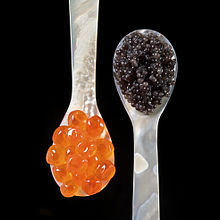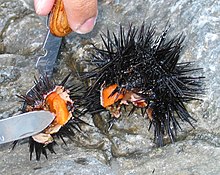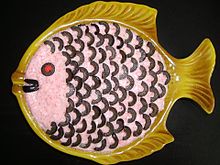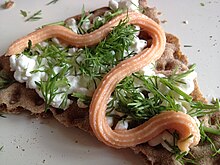Roe
This articleneeds additional citations forverification.(December 2008) |


Roe,(/roʊ/ROH) orhard roe,is the fully ripe internaleggmasses in theovaries,or the released external egg masses, offishand certainmarine animalssuch asshrimp,scallop,sea urchinsandsquid.As aseafood,roe is used both as acookedingredient in many dishes, and as a raw ingredient fordelicaciessuch ascaviar.
The roe of marine animals, such as the roe oflumpsucker,hake,mullet,salmon,Atlantic bonito,mackerel,squid,andcuttlefishare especially rich sources ofomega-3fatty acids,[1]but omega-3s are present in all fish roe. Also, a significant amount ofvitamin B12is among the nutrients present in fish roes.[2]
Roe from asturgeonor sometimes other fish such asflathead grey mullet,is the raw base product from whichcaviaris made.
The termsoft roeorwhite roedenotes fishmilt,not fish eggs.
By country
[edit]Africa
[edit]South Africa
[edit]People inKwaZulu-Natalconsume fish roe in the form of slightly sourcurryor battered and deep fried.
Americas
[edit]Brazil
[edit]In southern Brazil, in particular in thelitoralparts of the state ofSanta Catarina(from Azorean colonization),mulletroesacks are consumed deep-fried or pan-seared by the locals.
Canada
[edit]Roe is extracted from sturgeon, salmon, sea urchins, etc.[a]Herring roe sacs are also extracted mainly for export to Japan (askazunokoq.v.).[3][4]But spawned herring roe was also traditional foodstuff for indigenous people ofBritish Columbia.[5]
The collection and consumption of herring roe is actually a long-standing native practice for the Indigenous people of the (Northern and Middle[5])Pacific coast.Traditional methods involves harvesting the naturally occurring "spawn-on-kelp" (Haida:k'aaw[6]or eggs laid on purposefully submergedhemlock[5]branches. Nowadays "spawnonkelp"is commercially produced, mostly bound for Japan.[b][4]()
Roe from theciscois harvested from the Great Lakes, primarily for overseas markets.
In the province of New Brunswick, roe (caviare) of theAtlantic sturgeonis harvested from the Saint John river.[citation needed]Whereas in coastalBritish Columbia,Fraser Riverwhite sturgeonare sustainablyfarmedto producecaviar.[7]
Chile
[edit]InChile,sea urchin roe is a traditional food known as an "erizo de mar". Chile is one of many countries that exports sea urchins to Japan in order to fulfill Japanese demand.
Dominican Republic
[edit]In Dominican Republic, dried and smoked herring roe ( "huevas de arenque" ) is eaten. Unlike in some countries, it's generally cooked before consumption.
Peru
[edit]In Peru, roe is served in many seafood restaurants sauteed, breaded and pan fried, and sometimes accompanied by a side of fresh onion salad. It is called Huevera Frita. Cojinova (Seriolella violacea) yields the best roe for this dish. Despite the fact that many people like it, it is hardly considered a delicacy. Upscale restaurants are not expected to offer it, but street vendors and smaller restaurants will make their first daily sales of it before they run out. Cojinova itself (considered a medium quality fish) is caught for its fish meal, not for its roe, which is considered a chance product. Sea urchin roe is considered a delicacy and it is used (at customer request) to add strength toceviche.
United States
[edit]
In the United States, several kinds of roe are produced:salmonfrom the Pacific coast,shadandherringspecies such as theAmerican shadandalewife,mullet,paddlefish,American bowfin,and some species ofsturgeon.Shad, pike, and other roe sometimes are pan-fried with bacon.Spot prawnroe (hard to find) is also a delicacy from the North Pacific.Flounderroe, pan-fried and served withgritsis popular on the Southeastern coast.
Herring roe harvested in Alaska are mostly shipped to Japan[3](cf.kazunokounder#Japan). The indigenous people (Tlingit) of theSitka Soundhad traditionally collected and eaten herring roe.[8][9](cf. also#Canada)
Asia
[edit]Cambodia
[edit]In Cambodia roe (Khmer:ពងត្រី,pông trei) are fermented and usually eaten with steamed eggs,omelettesand other hen or duck egg dishes.[10]
China
[edit]In many regions in China, crab and urchin roes are eaten as a delicacy. Crab roe are often used as topping in dishes such as "crab roe tofu" ( giải phấn đậu hủ ).Nanxiang Steamed Bun Restaurantserves "crab roexiaolongbao"as their special. Shrimp roes are also eaten in certain places, especially around the downstream ofYangtze River,such asWuhu,as toppings for noodle soup.[citation needed]
India, Pakistan and Bangladesh
[edit]
Among the populace of eastern India, roe that has been deeply roasted over an open fire is a delicacy. In this region, the roe ofrohuis also considered a delicacy and is eaten fried or as a stuffing within a friedpointed gourdto makepotoler dolma.
Roe from theilishfish is considered a delicacy inBangladesh.The roe is usually deep-fried, although other preparations such as mashed roe where the roe crushed along with oil, onion and pepper, or curry of roe can also be found.
All along theKonkan coastand NorthernKerala,the roe ofsardines,black mackereland several other fish is considered a delicacy. The roe can be eaten fried (after being coated with red chilli paste) and also as a thick curry (gashi). InGoaandMalvan,roe is first steamed or poached, then coated with salt and chilli powder and then shallow fried or roasted on a tawa (flat pan). In the state ofKerala,roe is deep fried incoconut oil,and is considered a delicacy. A common method of quick preparation is to wrap the roe in wet banana leaves and cook it over charcoal embers.
InOdishaandWest Bengal,roe of several fresh-water fish, includinghilsa,are eaten, the roe being cooked separately or along with the fish, the latter method being preferred for all but large fishes. Roe, either light or deep-fried are also eaten as snacks orappetizersbefore a major meal.
All along theIndus Riverand Specially South PakistanSindh,the roe ofPalla (fish),and several other fish is considered a delicacy. The roe can be eaten fried (after being coated with red chilli paste) and also as a thick curry (Salan/Curry). coated with salt and chilli powder and then shallow fried or roasted on a tawa (flat pan).
Indonesia
[edit]Pepes telur ikanis a dish of steamed or fried spiced roe wrapped in banana leaf.[11]InMakassar,It is made fromflying fishroe or locals calledikan tuing-tuing.Also inGresik,thepepesis made fromJava barbroe or locals calledikan bader.
InKendal,telur ikan mimihas become aRamadandish.[12]It is made fromhorseshoe crabroe with grated coconut.
Iran
[edit]In theCaspianprovinces ofGilanandMazandaran,several types of roe are used. Calledashpalorashbal,roe is consumed grilled, cured, salted, or mixed with other ingredients. If salted or cured, it is consumed as a condiment. If used fresh, it is usually grilled, steamed, or mixed with eggs and fried to form acustard-like dish called "Ashpal Kuku".
Besides the much sought-aftercaviar,roe fromkutum(also known as Caspian white fish orRutilus frisii kutum),Caspian roach(called "kuli" inGileki),bream(called "kulmeh" inGileki), and Caspiansalmonare highly prized. Roe fromcarpis less common and barbel roe is also occasionally used.
Israel
[edit]Several sections of theIsraeli cuisineinclude roe. InModern Hebrew,roe is commonly referred to by its Russian name "ikra" (איקרה). When necessary, the color is also mentioned: white or pink, as appropriate. Israeli "white ikra" is commonly made ofcarporherringeggs, while "red ikra" is made offlathead mulleteggs or, in rarer cases,salmoneggs. The term "caviar"is separate, and denotes onlysturgeoneggs.
Ikra is served as a starter dish, to be eaten withpitaor similar breads, particularly inArabrestaurants. It can also be purchased in stores, in standard-sized plastic packages. In home cooking it is similarly served as a starter dish.
InJudaism,roe fromkosher fish—fish with fins and scales—is considered kosher. Like fish in general, it is consideredpareve.However, roe is considered kosher only if the fish from which it is harvested is kosher as well.Caviarfromsturgeonis therefore not considered kosher from an Orthodox Jewish perspective, as that fish is not understood to have scales under Orthodox interpretations of Jewish law.
For most observant Orthodox Jewish consumers who keep kosher, roe orcaviarmust be processed under kosher supervision as well. The only exception to this rule is red roe, thanks to a widely acceptedresponsaby the Bais Yosef.[13]
Japan
[edit]


Various roe types are used inJapanese cuisine,including the following which are used raw insushi:
- Ebiko -Shrimproe.[14]
- Ikura(イクラ) -Salmonroe. Large reddish-orange individual spheres. It is aloan wordfrom the Russian, "икра" (roe, in this contextcaviar)
- Sujiko (すじこ/ cân tử) - Salmon roe sac whole pieces. Sujiko is darker (red to dark-red), also sweeter in taste.
- Kazunoko(Sổ の tử /鯑) -herringroe sac, yellow or pinkish, having a firm, rubbery texture and appearance, now usually brined. ().
- Karasumi(カラスミ/ liệp tử) - dried mullet roe, a specialty ofNagasaki.Along with sea urchin andkonowata(cf.kuchikobelow) it is considered one of the big threechinmiof Japan.
- Kuchikoorkonoko- sea cucumber roe. Often dried.[16]
- Masago (Chân sa tử)-Capelinroe, similar to Tobiko, but smaller.
- Tarako(たらこ/ tuyết tử) - SaltedAlaska pollockroe, sometimes grilled.
- Mentaiko(Minh thái tử) - Alaska pollock roe sac, cured and spiced withred pepper.Mentaiko is usually pink to dark red.
- Tobiko(Phi び tử) -Flying fishroe, very crunchy, reddish orange in color.

- Uni (うに/ vân đan) -Sea urchinroe, used insushi,also preserved uni (packed in jars). Orange to pale yellow. Theichigonisoup is a northern specialty (also available canned).[17]
Korea
[edit]All kinds of fish roe are widely eaten inKorean cuisine,including the popular sea urchin, salmon, herring, flying fish, cod, among others.Myeongranjeot(명란젓) refers to thejeotgal(saltedfermentedseafood) made withpollockroe seasoned withchili pepperpowders. It is commonly consumed asbanchan,small dish accompanied with cooked rice or ingredient foraltang(알탕), a kind of jjigae (Korean stew).
Albapis abibimbapmade with roe.
Lebanon
[edit]Sea urchin roe, ortoutiaتوتية as it is known locally, is eaten directly from the sea urchin shell fresh using a small spoon. Some people add a twist of lemon juice to the roe and eat it in Lebanese flat bread.
Malaysia
[edit]Particularly in Sarawak, Malaysia, Toli Shad fish roe is a popular delicacy among locals and tourists. The roe is usually found in the street market in Sarawak's capital city of Kuching. The roe can be sold for up to US$19 per 100 grams and is considered expensive among locals, but the price can reach up to US$30 in other states of Malaysia.
The roe is usually salted before sale but fresh roe is also available. The salted roe is usually pan fried or steamed and eaten with steamed rice. The fish itself is also usually salted and served along with the roe.
Oceania
[edit]New Zealand
[edit]The Māori people and other New Zealanders eat sea urchin roe, called "kina".[18]Kina is sold in fish shops, supermarkets, and alongside the road. Most commercial kina is imported from theChatham Islands.
Europe
[edit]All around the Mediterranean,bottargais an esteemed specialty made of the cured roe pouch offlathead mullet,tuna,orswordfish;it is called bottarga (Italian), poutargue or boutargue (French), botarga (Spanish), batarekh (Arabic) or avgotaraho (Greek αυγοτάραχο).
Denmark
[edit]The most commonly eaten roe in Denmark iscodroe, usually sold canned with added water, starch, oil, salt, and tomato puree and then boiled and preserved. It is served sliced, either as is or slightly roasted in a pan, on top of rye bread, sometimes topped with remoulade and/or lemon. An everyday food item on many Danish lunch tables. Lumpfish(stenbider) roe is another roe used inDanish cuisine.It is considered somewhat of a luxury item and is primarily used as a condiment on top of halved or sliced hard-boiled eggs, on top of mounds ofshrimp,or in combination with otherfishor seafood.
France
[edit]Sea urchinroe (oursininFrench) is eaten directly from the sea and in restaurants, where it is served both by itself and in seafood platters, usually spooned from the shell of the animal.Crab,shrimpandprawnroe still attached to those animals is also considered a delicacy.
Finland
[edit]Common whitefishand especiallyvendacefrom the fresh water lakes in Finland are renowned for the excellent delicate taste of the roe. Roe is served as topping of toast or on blini with onion andsmetana.
Greece
[edit]

Taramáis salted and cured carp or cod roe used to make taramosaláta, aGreekmezeconsisting of taramá mixed with lemon juice, bread crumbs, onions, and olive oil; it is eaten as a dip.
Avgotaraho(αυγοτάραχο) or botargo is the prepared roe of theflathead mullet.
Italy
[edit]Bottargais a popular ingredient in the south of Italy. It consists of the salted and dried roe pouch of theAtlantic bluefin tuna;it can also be prepared with the dried roe pouch of theflathead mullet.It is used minced for dressing pasta or sliced with olive oil and lemon on bread. On the islands of Sardinia and Sicily, fresh sea urchin roe is widely consumed, both as is and as a pasta sauce. Its consumption is limited to certain months of the year to preserve the sea urchin.
Norway
[edit]Norwegiancaviaris most commonly made fromcod,but caviar made fromlumpsuckerorcapelinroe is also available. During winter season, when skrei, winter cod is available, roe is cooked in its sack and served with cod liver and poached cod. This traditional dish is particularly popular in coastal Norway and is called mølje. In some areas it is also common tofrythe roe from freshly caught fish, to be eaten onbreador withpotatoesandflatbread.
Portugal
[edit]Codfish roe and sardine roe are sold in olive oil. The fresh roe of hake (pescada) is also consumed (a popular way of eating it is boiled with vegetables, and simply seasoned with olive oil and a dash of vinegar). In the South of Portugal, the "ouriço do mar" (sea urchin) is highly appreciated. In the Sines area (Alentejo), a layer of dried pine needles is placed on the ground and, on top of it, a layer of sea urchins. This layer is topped with a second layer of dried pine needles. The pile is set on fire. The roe is removed from the cooked sea urchins and eaten. Sea urchin is not consumed in May, June, July, and August.
Romania
[edit]
Fish roe is very popular in Romania as a starter (likesalată de icre) or sometimes served for breakfast on toasted bread. The most common roe is that of the European carp; pike, herring, cod are also popular. Fried soft roe is also a popular dish. Sturgeon roe is a delicacy normally served at functions.
Russia and ex-USSR countries
[edit]
InRussian,all types of fish roe are calledikra(икра), and there is no linguistic distinction between the English words "roe" and "caviar". Also, Russians tend to translate any "ikra" as "caviar", thus creating the impression of availability of sturgeon roe.
Sturgeonroe, calledchyornaya ikra(чёрная икра, "black caviar") is most prized. It is followed in prestige bysalmonroe calledkrasnaya ikra(красная икра, "red caviar" ), which is less expensive, but still considered a delicacy. Both types of roe are usually served lightly salted on buttered wheat bread, or as an accompaniment forblini,or used as an ingredient in varioushaute cuisineand festive dishes. The butter on bread may soften the taste of large pellets of black or red roe this way, by making it more dull, and the bread should be soft and fresh rather than soggy, crisp or bun-like dense.
More common roes, such ascod,Alaska pollock,andherringones are everyday dishes, combining richness in protein with low price. Saltedcod or pollock roeon buttered bread is common breakfast fare and herring roe is often eaten smoked or fried. The roe of freshwater fish is also popular but the commercial availability is lower.Soft roeof various fishes is also widely consumed, mostly fried, and is a popular cantina-style dish.
- For those "everyday" roes, the buttered bread makes sense, since the canned roe is more salty thancaviarsturgeon roe.
- Capelin roe mixed with cream is sold inconvenience storesof Russia as a more gentle-tasting variant of aforementioned canned roe spreads.
Roe found in driedvoblafish is considered delicious by some; though dried vobla roe is not produced separately as a stand-alone dish, roe-carrying vobla is prized.
Spain
[edit]Cod and hake roe is commonly consumed throughout Spain in many different forms: sautéed, grilled, fried, marinated, pickled, boiled, with mayonnaise, or in salad.Tunaandlingdry brined roe is traditional inAndalusiaand the Mediterranean coasts since antiquity. In all of the Spanish coastal regions,sea urchin roeis considered a delicacy and consumed raw. Roe from the Mediterranean grey mullet,Mugil cephalus,is asustainable roeresembling sturgeon roe that is marketed from Spain to countries around the world.[19]
Sweden
[edit]
Smoked and saltedcodroe paste known assmörgåskaviaris commonly served as sandwich topping in Sweden.
Lightly salted roe of thevendaceis called Löjrom in Swedish. It is naturally orange in colour. The most sought after type isKalix Löjromfrom Kalix in the northern Baltic sea.
Most Löjrom consumed in Sweden is however imported frozen from North America.
Stenbitsrom, the roe oflumpfishis naturally a bleak unappetizing gray, but is coloured black (to emulate black caviar) or orange (to emulate Löjrom). Stenbitsrom sells in much larger volume than Löjrom, but it has two drawbacks: it tastes of little more than its salt and artificial additives, and the colour additives tend to bleed into other parts of the food served with it (such as a boiled egg), or to discolour porcelain dishes.
There is also a trend to use more Laxrom (salmon roe), which is a natural orange colour, with a large diameter.
United Kingdom
[edit]Though not popular, herring roe is sold within many British supermarkets. Battered cod roe can also be bought from many fish and chip shops. Various tinned roes are on sale in supermarkets e.g. soft cod roes, pressed cod roes and herring roes.
See also
[edit]Explanatory notes
[edit]References
[edit]- ^Roe of Marine Animals Is Best Natural Source of Omega-3Archived2016-03-08 at theWayback MachineScience Daily,11 December 2009.
- ^Roe, fish, mixed, rawArchived2019-09-01 at theWayback Machine,Self Nutrition Data, accessed 2019.09.01
- ^abcMackovjak, James (2022)."Chapter 1. Alaska Herring, The Basics; Chapter 9. Genesis and Management of Alaska's Ro-Herring Fishery".Alaska Herring History: The Story of Alaska’s Herring Fisheries and Industry.University of Alaska Press. pp. 20–21, 143–147.ISBN9781646423439.
- ^abHourston, A. S.; Haegele, C. W. (1980),Herring on Canada's Pacific Coast(PDF),Department of Fisheries and Oceans, pp. 6–8
- ^abcTurner, Nancy J.(1995)."Western Hemlock (Pine Family)Tsuga heterophylla(Raf.) Sarg. (Pinaceae) ".Food Plants of Coastal First Peoples.Royal British Columbia Museum Handbook 34. University of B. C. Press. pp. 33–35.ISBN0774805331.
- ^Turner, Nancy J.(2004),Plants of Haida Gwaii,Illustrated byFlorence Edenshaw Davidson,Winlaw, B.C.: Sono Nis Press, pp. 197–199,ISBN1-55039-144-5
- ^Rockel, Nick (11 February 2015)."B.C. caviar farmer takes over where Russia left off - The Globe and Mail".The Globe and Mail.Archivedfrom the original on 18 July 2017.Retrieved11 September2017.
- ^Mackovjak (2022),p. 166.
- ^Thornton, Thomas F. (2011),Being and Place among the Tlingit,University of Washington Press, p. 125,ISBN0295800402
- ^Thaitawat, Nusara (2000).The Cuisine of Cambodia.Thailand: Nusara & Friends Co. Ltd. p. 31.ISBN978-9-748-77885-3.
- ^"Resep Pepes Telur Ikan yang Cocok untuk Menu Diet".kumparan.com(in Indonesian). 9 November 2021.Archivedfrom the original on 29 June 2023.Retrieved14 August2022.
- ^Rasyid, Shani (5 April 2022)."Mencicipi Telur Mimi, Sajian Berbuka Puasa yang Unik Khas Kendal".merdeka.com(in Indonesian).Archivedfrom the original on 14 August 2022.Retrieved14 August2022.
- ^"CRC Kosher Articles:On Kosher Fish - FAQ".www.crcweb.org.Archivedfrom the original on 12 August 2017.Retrieved21 August2017.
- ^Suetsugu, Bobby (2005).Samurai Sushi: A Field Guide to Identifying and Appreciating the World's Most Unique Wraps, Rolls, and Sashimi.Becker & Mayer.p. 233.ISBN9780760759332.
- ^Weinstein, Jay (2010),The Ethical Gourmet,Broadway Books,p. 266,ISBN0307484394
- ^Murata, Yoshihiro[in Japanese](2006).Kaiseki: The Exquisite Cuisine of Kyoto's Kikunoi Restaurant.Kodansha International.p. 140.ISBN9784770030221.
- ^Yokota, Yukio. "Fishery and consumption of the sea urchin in Japan". InBijl, Paul de(ed.).
{{cite book}}:Missing or empty|title=(help) - ^"2. Sea urchins - Starfish, sea urchins and other echinoderms - Te Ara Encyclopedia of New Zealand".Archivedfrom the original on 2008-10-15.Retrieved2009-07-05.
- ^Mujjo’l CaviarArchived2020-01-03 at theWayback Machine,mujjolcaviar.com, about-us, accessed January 1, 2020



